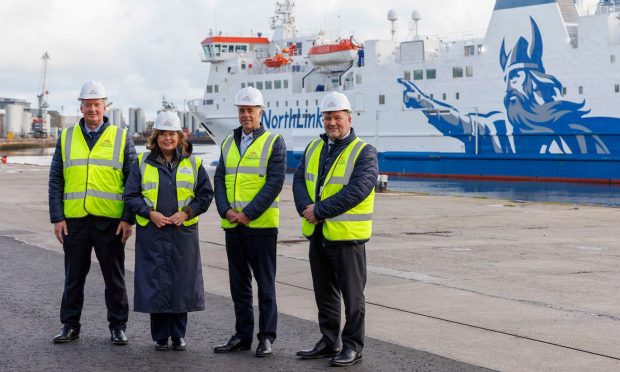Ferries travelling to and from the Northern Isles will be able to plug into a “clean” power supply at Port of Aberdeen (PoA) following a £1 million-plus investment in new infrastructure.
The MV Hrossey and MV Hjaltland ferries, which ply back and forth between the Granite City, Shetland and Orkney every day, have already been converted to accept shore power.
Installation of the new equipment will put an end to them having to use noisy fossil fuel-powered generators while berthed at PoA.
It is hoped similar facilities could eventually be introduced in Lerwick and Kirkwall.
Port of Aberdeen bosses targeting last quarter of 2024 for big switch-on
The Aberdeen project is funded by Caledonian Maritime Assets Limited (CMAL), which owns the Serco NorthLink-operated ferries.
And it is expected to mitigate more than 1,300 tonnes of CO2 equivalent per year.
First power is expected in Q4 2024.
PoA chief executive Bob Sanguinetti hailed the project as a major step for the port’s net-zero ambitions.
He added: “We are delighted to be part of this forward-thinking initiative, which is an important strand of our industry-leading net-zero strategy.
“We are committed to reducing our environmental impact and providing a cleaner, more sustainable port for our stakeholders.”
Port of Aberdeen’s UK first
Earlier this year PoA became the first port in the UK to commit to net-zero operations by 2040.
Unlike other ports, its carbon-busting efforts – backed by a £55m investment over the next 10 years – covers emissions from visiting ships.
Mr Sanguinetti told The Press and Journal he and his management team were increasingly looking for renewable energy sources to power quayside activity and scouring the market for the best green energy tarriffs.
He added: “The expanded port can play a pivotal role in the emergence of green economic growth in the wider maritime industry and support new, high-quality jobs in energy, trade, and tourism.
“Strong partnerships and investment across the public and private sectors are essential to deliver this transformational change.”
The new infrastructure will include a 1.7 MVA (megavolt-amperes) electrical supply, a new substation, and a quayside cable management system at Serco NorthLink’s facility in the port’s north Harbour.
As well as cracking down on carbon emissions, the project is expected to improve air quality and reduce noise.
‘Cutting-edge’ shore power
CMAL chief executive Kevin Hobbs said: “This investment in cutting-edge shore power infrastructure at Port of Aberdeen is a pivotal step towards a greener maritime future.
“We’re not just reducing emissions but shaping a sustainable future for maritime transport – one that resonates with CMAL’s commitment to environmental sustainability and innovation.”
Serco NorthLink managing director Stuart Garrett said: “Targeting the annual eradication of 1,300 tonnes of CO2, the equivalent of almost 24 tankers of marine gas oil, can only be seen as a positive environmental step forward.
“MV Hjaltland and MV Hrossey are fully wired and ready to receive shore power when commissioning has been completed.”
Minister says ports and harbours have ‘key role’ in reducing Scotland’s transport emissions
Meanwhile, Transport Minister Fiona Hyslop said: “It’s great to see Port
of Aberdeen aiming to be the first UK port to achieve net-zero by 2040.”
“Ports and harbours are crucial gateways to Scotland and have a key role to play in reducing transport emissions, as well as supporting national, regional and local
economies.”





Conversation